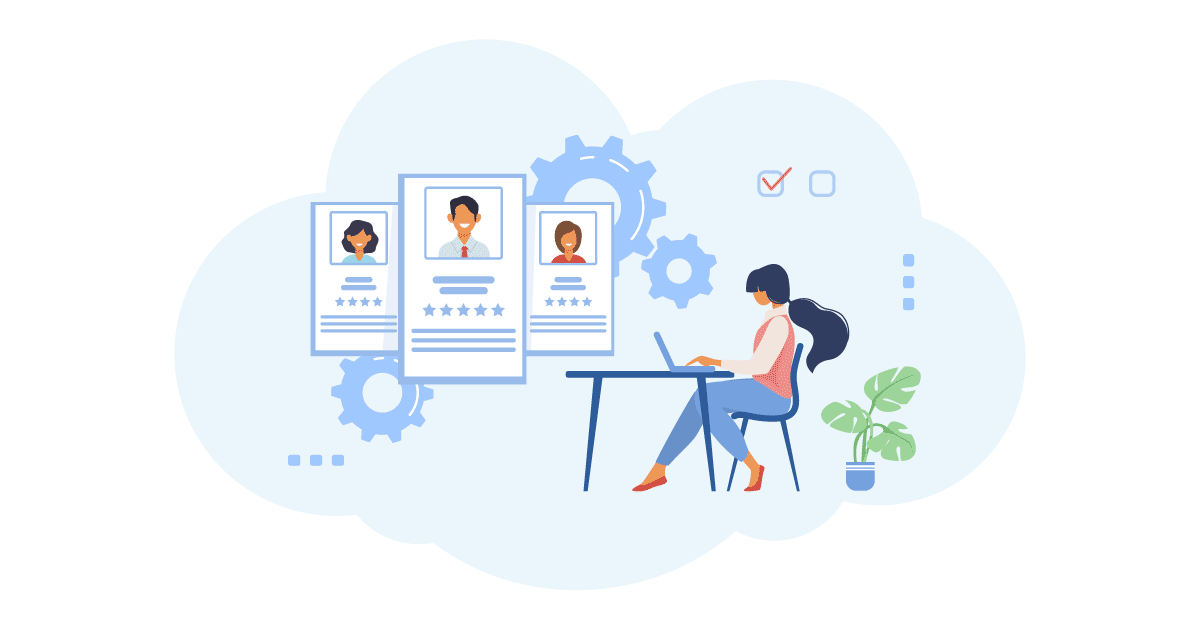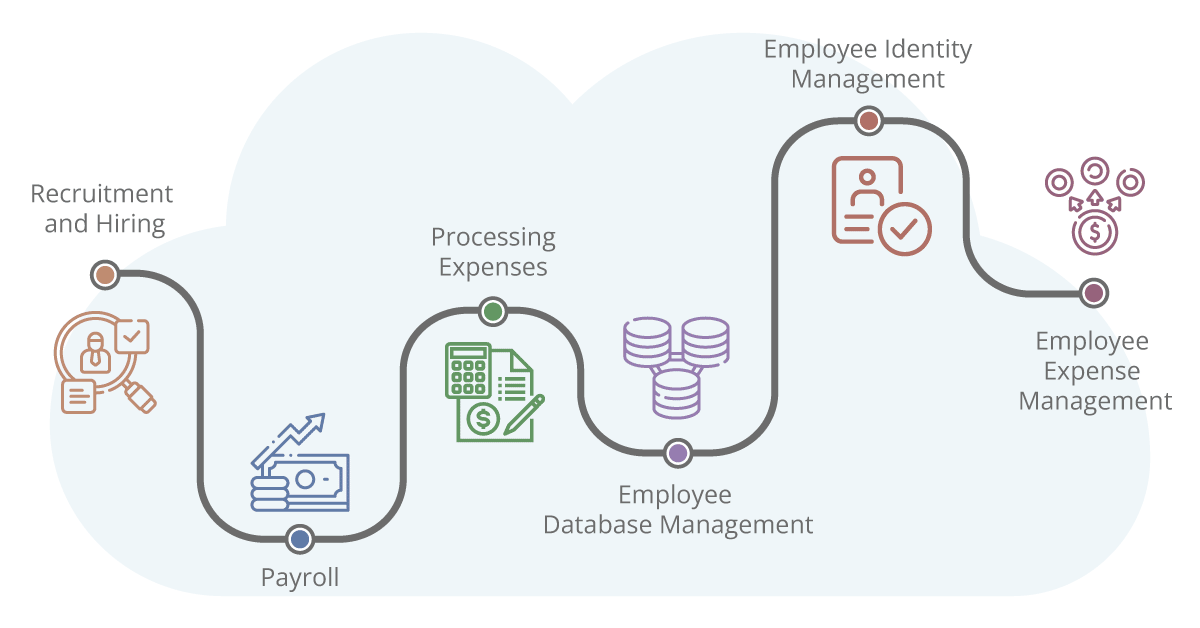Are you tired of drowning in paperwork and feeling overwhelmed with HR tasks? Good news – HR automation can help! Think of it as your trusty sidekick, here to optimize and streamline all of your HR business processes.
HR automation is an end-to-end process that integrates and automates workflows, all to make your life easier. This means that HR process automation requires connecting multiple applications, but it all starts with the foundational SaaS application, your HR information system (HRIS).
Aonflow iPaaS – Free for First 3 Months!
Build and run up to 1,500 transactions monthly with no cost. No payment info needed!
But before we delve into HR automation using iPaaS, let’s explore more about HR Automation, challenges in HR without automation, and implementing HR automation using iPaaS.
What is HR automation?
HR automation refers to the use of technology to streamline and optimize human resources processes, including tasks such as recruitment, onboarding, performance management, and payroll. The goal of HR automation is to improve the efficiency, accuracy, and effectiveness of HR processes by reducing manual tasks and automating routine processes.
HR automation can involve the integration of various software applications, such as human resource information systems (HRIS), applicant tracking systems (ATS), performance management systems, and payroll systems. By connecting these systems and automating workflows, HR teams can save time, reduce errors, and improve the overall employee experience.
Some common examples of HR automation include automated email reminders for performance reviews, automated job postings and candidate screening, automated onboarding processes, and automated payroll processing.
HR automation is a powerful tool for HR teams to optimize their processes and improve the overall effectiveness of their organization. By using technology to streamline routine tasks and reduce manual processes, HR teams can focus on more strategic work and provide better support for their employees.
Let’s talk about challenges in HR without automation
Without automation, HR processes can be incredibly time-consuming, resource-intensive, and error-prone. HR teams are often swamped with administrative tasks such as data entry, filing, and tracking employee information, leaving them with little time for more strategic work.
Additionally, without automation, HR processes can be prone to errors and inconsistencies. This can lead to mistakes in employee data, payroll errors, compliance issues, and other serious problems that can impact the entire organization.
Recruiting can also be a significant challenge without automation. Without a centralized system for managing job postings, resumes, and candidate communications, it can be challenging to keep track of applicants and ensure a smooth hiring process. This can result in missed opportunities to hire top talent, longer time-to-hire, and even negative impacts on the employer brand.
Without automation, HR processes can be a significant drain on resources and can impact the overall effectiveness and efficiency of the organization. By automating HR processes, organizations can free up time for more strategic work, reduce errors and inconsistencies, and streamline their HR operations for better results.
What does HR automation entail?
HR automation entails the use of technology to optimize and streamline various human resource processes. The specific processes that can be automated will depend on the organization’s needs, but common areas of focus include recruitment, onboarding, performance management, payroll, and compliance.
To implement HR automation, an organization will typically begin by identifying which processes can be automated and selecting the appropriate software tools to achieve this. These tools may include human resource information systems (HRIS), applicant tracking systems (ATS), performance management systems, and payroll software.
Once the appropriate software tools have been selected, the organization will need to integrate these tools with existing systems and data sources to ensure a seamless flow of information. This may involve configuring APIs, creating custom integrations, or leveraging pre-built connectors provided by the software vendors.
Once the systems are integrated, the organization can begin to automate various HR processes. For example, they may automate the process of posting job openings to various job boards, collecting resumes, and screening candidates. They may also automate onboarding processes, such as sending welcome emails, collecting new hire paperwork, and assigning training modules.
Other examples of HR automation include automated performance review reminders, automatic data entry into payroll systems, and the use of chatbots or other AI-powered tools to handle employee inquiries and requests.
HR automation entails the use of technology to optimize HR processes and free up HR teams to focus on more strategic work. By automating routine tasks and reducing manual processes, organizations can improve the efficiency, accuracy, and effectiveness of their HR operations.
HR automation using iPaaS in a post-COVID world
The COVID-19 pandemic has changed the way we work, and as we begin to emerge from the crisis, organizations are looking for ways to optimize and streamline their operations. One area that is seeing a lot of interest is end-to-end HR automation.
HR automation involves automating the entire HR process, from recruitment and onboarding to performance management and payroll. By automating all aspects of HR, organizations can improve efficiency, reduce errors, and provide a better employee experience.
Recruiting is one area where end-to-end HR automation can be particularly effective. With automated job postings, candidate screening, and communication, organizations can quickly and efficiently identify and hire top talent. This can be especially important in a post-pandemic world, where many organizations are struggling to find qualified candidates for critical roles.
Onboarding is another area where end-to-end HR automation can make a big difference. With automated workflows for new hire paperwork, training, and orientation, organizations can ensure that new employees get up to speed quickly and feel welcome and supported from day one.
Performance management is also an area where automation can be beneficial. By automating reminders for performance reviews and tracking employee progress, organizations can ensure that employees are getting the support they need to succeed and that the organization is meeting its goals.
Finally, payroll is an area where automation can save time and reduce errors. With automated data entry and calculations, organizations can ensure that employees are paid accurately and on time and that compliance requirements are met.
End-to-end HR automation can be a powerful tool for organizations looking to optimize their HR processes and provide a better employee experience. By automating all aspects of HR, organizations can save time, reduce errors, and focus on more strategic work.
How to ascertain if you need HR process automation?
Deciding whether to automate your HR processes can be a complex decision that requires careful consideration of your organization’s needs and goals. Here are some factors to consider when deciding whether to automate your HR processes:
Time-consuming and repetitive tasks: If your HR team spends a lot of time on tasks that are repetitive or time-consuming, such as data entry or paperwork, automation may be a good option. By automating these tasks, your team can focus on more strategic work that adds value to the organization.
Compliance requirements: If your organization has complex compliance requirements, such as in the case of regulations regarding payroll, benefits, or safety training, automating these processes can help ensure that you meet all regulatory requirements and avoid costly fines or penalties.
Scaling operations: If your organization is growing rapidly or has a large workforce, it may be difficult for your HR team to keep up with the demands of manual processes. Automation can help scale your HR processes to meet the needs of your organization.
Accuracy and consistency: Manual processes can be prone to errors and inconsistencies, which can cause frustration for employees and waste time for your HR team. Automation can help ensure that processes are consistent and accurate, leading to a better employee experience and improved efficiency.
Employee experience: By automating HR processes, you can provide a better experience for your employees, with streamlined onboarding, automated reminders for performance reviews, and faster resolution of employee inquiries.
In summary, if your HR team is spending a lot of time on repetitive or time-consuming tasks, struggling to meet compliance requirements, struggling to keep up with the demands of a growing workforce, or looking to provide a better employee experience, automation may be a good option for your organization.
HR onboarding and off-boarding iPaaS automation
Onboarding and offboarding are critical HR processes that can benefit greatly from automation. Here’s a closer look at how automation can improve these processes:
Onboarding Automation:
Streamline paperwork: Automating the collection and processing of new hire paperwork can reduce errors and speed up the onboarding process. This can be done through the use of electronic forms or digital signatures, which eliminate the need for paper-based processes.
Personalized welcome: Automated welcome emails or messages can be sent to new hires, introducing them to the company culture and providing information about their first day. This can help new employees feel welcome and supported from the start.
Training management: Automating training assignments and tracking progress can ensure that new hires complete required training promptly, reducing compliance risk and improving job performance.
Provisioning: Automation can be used to provision new hires with the necessary equipment, software, and access to systems they need to do their jobs. This can reduce delays and ensure that new hires are productive from day one.
Off-boarding Automation:
Security and compliance: Automated workflows can help ensure that all offboarding tasks are completed in a timely and compliant manner, including revoking system access, collecting company equipment, and ensuring that all required paperwork is completed.
Exit interviews: Automating the exit interview process can provide valuable feedback to the company and help identify areas for improvement.
Payroll and benefits: Automating payroll and benefits processing for departing employees can ensure that they receive their final paycheck and any other benefits owed promptly.
Aonflow is the leading integration platform.
You can kick-start by integrating your first-ever workflow in just a matter of minutes.
Alumni network: Automated messages or surveys can be sent to departing employees to maintain a positive relationship and potentially build a talent pipeline.
Overall, automation can help streamline HR onboarding and offboarding processes, reduce errors, improve compliance, and provide a better experience for new hires and departing employees alike.
Automation Roadmap for HR Departments:
Now, let’s talk about the many HR processes that can benefit from automation. We’re talking about recruiting, employee onboarding and offboarding, single sign-on (SSO) and identity management, training, payroll accounting, performance management, and much more.
Don’t get bogged down with tedious tasks and administrative work. Let HR automation take the reins. You’ll be amazed at how much more efficient and effective your HR processes become.
Recruitment and Hiring:
Automating recruitment and hiring can save HR departments time and improve the candidate experience. Some possible automation solutions include:
- Applicant tracking systems (ATS) to manage resumes and job postings
- Interview scheduling software to reduce back-and-forth emails and phone calls
- Background check and pre-employment screening software to streamline the vetting process
- Automated reference checking to save time and improve accuracy
Payroll:
Payroll processing can be complex and time-consuming, making it an ideal area for automation. Some possible automation solutions include:
- Payroll software to automate tax calculations, deductions, and direct deposit
- Time and attendance tracking software to reduce errors and improve compliance
- Automated reporting to save time and reduce errors
- Integration with benefits administration software to streamline processes
Processing Expenses:
Managing employee expenses can be a headache for both employees and HR departments. Automation can help simplify the process and reduce errors. Some possible automation solutions include:
- Expense management software to track expenses and receipts
- Automated approval workflows to streamline the approval process
- Integration with payroll software to ensure timely reimbursement
- Real-time reporting to provide insights into spending trends
Employee Database Management:
Automating employee database management can reduce errors and save time. Some possible automation solutions include:
- HR information system (HRIS) to store employee data and track employee information
- Automated onboarding and offboarding workflows to update the employee database in real-time
- Self-service portals for employees to update their information, reducing the workload for HR departments
Employee Identity Management:
Managing employee identities and access to company systems can be time-consuming and prone to errors. Automating this process can improve security and reduce the risk of data breaches. Some possible automation solutions include:
- Identity and access management (IAM) software to control access to company systems
- Single sign-on (SSO) solutions to reduce the number of login credentials employees need to remember
- Multi-factor authentication (MFA) to increase security
Employee Expense Management:
Automating employee expense management can reduce errors and ensure timely reimbursement. Some possible automation solutions include:
- Expense management software to track expenses and receipts
- Automated approval workflows to streamline the approval process
- Integration with payroll software to ensure timely reimbursement
- Real-time reporting to provide insights into spending trends
Automating HR processes can save time, reduce errors, improve compliance, and provide a better experience for both employees and HR departments.
Why Aonflow iPaaS for HR automation?
Aonflow is an ideal choice for HR automation for several reasons.
Firstly, it automates every stage of your business, providing comprehensive coverage for all HR processes. With managed, prebuilt solutions, the platform leverages AI/machine learning to manage integrations, including self-healing and error management. This level of automation saves time and reduces errors, leading to improved efficiency and compliance.
Secondly, Aonflow has over a decade of experience in HR process automation and has thousands of customers. This experience translates into deep subject matter expertise and guidance on best practices. With Aonflow, businesses can benefit from a high level of end-to-end coverage and customizable solutions tailored to their specific needs.
Thirdly, the Aonflow platform is powerful and scalable, making it ideal for handling complex integrations and growing organizations. It can integrate all applications, automate HR processes, and provide a streamlined experience to eliminate operational inefficiencies. This scalability ensures that the platform can grow and adapt to the business, providing long-term value.
Lastly, Aonflow is accessible to everyone. With an intuitive UI, business users can self-serve and manage automation without coding. Easy-to-use monitoring and error management means that businesses do not have to rely on technical resources to run their operations, providing greater flexibility and autonomy.
Aonflow is an ideal HR automation platform, offering comprehensive coverage, deep expertise, scalability, and accessibility to all businesses, leading to significant improvements in efficiency and compliance.
Aonflow iPaaS – Free for First 3 Months!
Build and run up to 1,500 transactions monthly with no cost. No payment info needed!


